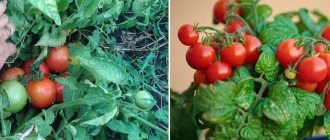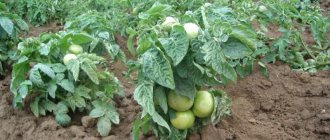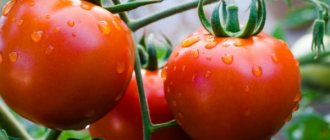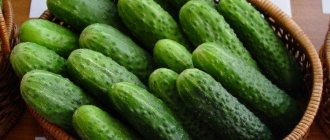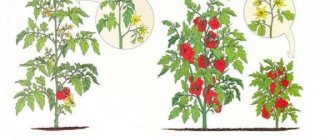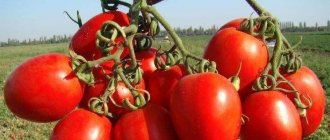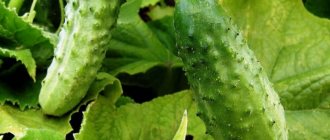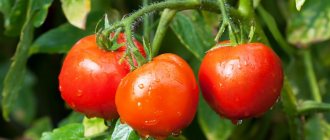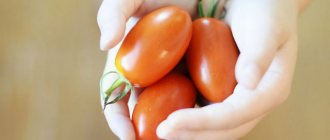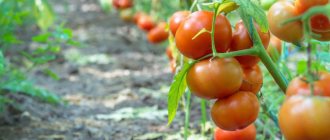AN IDEAL OPTION FOR GROWING TOMATOES IN A COLD REGION
I have been growing tomatoes for more than 30 years, having tested hundreds of varieties during this time and finally settled on, as it seems to me, the best and most reliable ones, which I will tell you about at the end of the letter.
As for agricultural techniques, based on my own experiments and advice from readers, I developed a universal method for growing tomatoes, which did not let me down even in the abnormally cold, rainy and cloudy summer of 2014, when the temperature dropped to 3° at night and did not exceed 10 during the day. °. My harvest was such that everyone in the gardening community came to see it. From 70 roots I collected 70 buckets of gorgeous trophies! And now I turn to the description of the technology.
First of all, I must say that I advise you to go to the store for seeds at the very last place, because you either need to collect them yourself or take them from successful and trusted summer residents (that’s why I’m not lazy to maintain active correspondence with other gardeners). I sow seedlings in the first ten days of March and prepare the seed material for this as follows.
First, I keep the seeds for disinfection in a one percent solution of potassium permanganate for half an hour, followed by washing them in clean running water, after which I place them in a box with fertile soil, which I immediately cover with a layer of snow: melt water promotes a more friendly emergence of seedlings.
I plant all the seedlings twice - first in small cups, and then in larger containers, so that the plants grow a powerful root system. In the phase of the second and sixth true leaves, I fertilize with an extract of double superphosphate: I dilute 1 tsp in 1 liter of hot water. fertilizers and, stirring occasionally, let the solution sit for 24 hours.
Standard low-growing ones for Siberia for open ground
The region has a fairly cold climate, but the breeders of our country do not stand still; they managed to develop high-yielding Siberian tomatoes, which are cultivated in such natural conditions. Standard species bear fruit well and produce an impeccable harvest when cultivated in open areas.
Buyan (Fighter)
The bush is low 40 - 45 cm, standard, determinate in appearance. The leaves are medium in size, dark in color, slightly wrinkled. Tomatoes ripen 95 days after germination of seedlings, weighing 65 - 90 grams. The tomato is purple in color and oblong in shape. It has a smooth surface, thick skin, and juicy pulp. Tomatoes are consumed fresh and salted. The variety is drought-resistant, this is a big plus for agricultural technicians who cannot moisten the crop in a timely manner.
boec
Note! Another name for tomatoes is indicated on packages of planting material - Buyan.
Nevsky
The early ripening crop is very small in stature (30 – 50 cm). The ripening time of berries is 90 – 100 days. The variety is undemanding, there is no need to tie it up. Ripe fruits are small, spherical, crimson in color, weight 45 - 55 g. Tomatoes have excellent taste and a long shelf life.
The plant is resistant to many infections. Easily tolerates lack of moisture. Among the main advantages of tomato is the ability to cultivate in urban conditions. But there are some disadvantages: low yield, demanding fertilizers.
Tomato varieties for polycarbonate greenhouses
Let's see what new tomato varieties have appeared for the Urals and Siberia in 2021.
We choose the most delicious tomatoes (tomatoes), self-pollinating and blooming all summer, resistant to late blight and, most importantly, withstanding large temperature changes (day heat and night cold).
“PINK DAWN” determinant, new
The plant is 60-80 cm high, fruiting is abundant and widespread. The variety is mid-early, suitable for growing in greenhouses and open ground; staking and pinching are recommended. The fruits are raspberry-colored, with delicate skin, multi-chambered, sweet, fragrant, very large (up to 420 g).
Best used for fresh salads and canning in large pieces.
Sowing seedlings at the end of March, beginning of April. Picking in the phase of the first true leaf. Planting seedlings in greenhouses in May. Planting pattern: 40x50 cm
"MONISTO EMERALD" indeterminate, newThe fruits of Monisto are amber, emerald-chocolate and pink.
A characteristic feature of the varieties of the Monisto group is their incredibly abundant and friendly fruiting. At this time, the plant is very decorative - small sugar cream in numerous clusters of 20-30 fruits densely cover the tall bush. Form into one stem, removing all the “stepchildren”.
An excellent variety with an amazing taste for preparing fresh salads, delicious snacks and colorful canned assorted dishes.
They ripen on the plant 110-120 days after emergence. Fruits weighing 35 g. Sowing for seedlings in March. Picking in the phase of the first true leaf. Planting in greenhouses in May.
"STAR OF SIBERIA", determinate hybrid
The plant is medium-sized (100-140 cm), staking and pinching are required. Ripens quite quickly (110-115 days).
Guaranteed to bear fruit in cold and damp summers. And under favorable conditions, the yield is simply amazing - up to a bucket of large fleshy fruits, weighing 200 g/m2.
The pulp is sweet, very aromatic and tasty, subject to timely feeding. Sowing seedlings in March-April to a depth of 1-2 cm. Picking in the phase of 2-3 true leaves. Planting seedlings in a greenhouse in April-May, in the ground in June. Planting pattern: 40×60 cm
“KING OF SIBERIA”, indeterminate, tall with a small number of leaves. Mid-season variety, formed into 1-2 stems. The 2nd stem is formed from the stepson located under the first brush. The remaining stepsons are removed; gartering to the trellises is required.
We suggest you read: How to choose the right rose seedlings
The fruits are heart-shaped, orange, dense, very tasty, with a high content of vitamins and beta-carotene, weighing 300-400 g. Ideal for baby and dietary nutrition.
Picking in the phase of 1-2 true leaves. Seedlings are fed 2-3 times with complete fertilizer. 7-10 days before planting, seedlings begin to harden. Seedlings are planted in heated greenhouses in April, in unheated polycarbonate greenhouses - in May at the age of 60-65 days.
"SIBERIAN GARDEN"
Mid-early Siberian giant for growing in a greenhouse
The plant, up to 2 m high, forms up to 5 clusters with large, smooth, crimson-colored fruits.
Stable yield up to 5 kg per plant, fruits weighing up to 600 g, few seeds, fleshy, 5-6 fruits in a cluster. The taste is tomato, sweet. The pulp of the fruit on the break is sugary and crystalline. When cut into slices they do not fall apart.
The purpose of the variety is mainly for salads, but it is also used for canning in slices, and the juice is very tasty.
The most delicious greenhouse tomatoes: “Biysky Rozan”, “Semko-Sinbad” F1, “Druzhok” F1, “Typhoon” F1, “Kostroma F1″, “Solebreti” F1, “Ilyich” F1, “Samara” F1, “Tornado” F1.
What you need to know about choosing a tomato variety
The Ural summer flies by quickly. The favorable time for tomato growth is only one hundred days. To ripen fruits, you need to adapt to climate requirements. For heat-loving tomatoes, a greenhouse can create comfortable conditions. It is possible to achieve success from growing tomatoes in it by providing them with good care, as well as choosing the right variety. In order to grow a bountiful harvest of tomatoes in a polycarbonate greenhouse, you need to follow certain rules:
- The varieties selected for this type of greenhouse must be resistant to microorganisms.
- It must have the ability to self-pollinate.
- The seeds need to be disinfected.
Note! In addition to taste, the selected variety must have a stable gene in the seed (it is found in zoned hybrids). This is necessary to fight infections and adapt to temperature changes.
For greenhouses of various sizes, it is important to select plants that are appropriate in height and compactness. They are selected according to certain criteria:
- Degrees of resistance to diseases, pests, and adverse conditions.
- Fruit ripening speed.
- Their sizes.
- Taste qualities.
- Yield indicators.
- A type of bush.
In addition to the main criteria, there are factors that influence the health of plants grown in greenhouse conditions and the success of the future harvest (microclimate, light, temperature, correct implementation of agrotechnical measures).
Ripening period
For the Urals, the optimal variety of tomato ripening is considered early. In short summer conditions (100 days), the plant should:
- grow from seeds;
- reach a period of biological maturity;
- form an ovary;
- Grow fruits by autumn.
Breeders from the Urals are studying the possibilities of plant adaptation to harsh climates and creating hardy early hybrids such as: “Ural”, “Kostroma”, “Titanic”.
Disease resistance
The criterion for selecting seeds for greenhouses is their resistance to microorganisms. This is important because it has different degrees of disease resistance in different types of tomatoes. The microclimate of greenhouses contributes to the emergence of diseases. It is extremely difficult to create ideal conditions for plants in them due to lack of light and high humidity. Only the presence of resistance in tomatoes to negative environmental influences will allow them to retain the productive characteristics of the variety.
Expert opinion
Stanislav Pavlovich
Gardener with 17 years of experience and our expert
Ask a Question
Important! Ural vegetable growers include early hybrids as tomatoes with high resistance to microorganisms and diseases: “Shustrik”, “Gina”, “Yarilo”, “Cavalier”, “Soyuz 3”, “Blagovest”, “Druzhok”, “Soyuz 8”.
Resistance to temperature changes
The modest possibilities of the Ural summer season cannot accommodate the growing potential of all stages of tomatoes. Therefore, tomatoes grow in covered structures. This state of affairs forces Ural gardeners to carefully select seeds. The best choice would be selected varieties. When there is a lack of sun and temperature fluctuations, experienced summer residents plant tomatoes: “Verlioka”, “Admiralteysky”, “Ural”, “De Barao”.
Stress resistance
For a heat-loving vegetable crop, growing in the Ural climate is stressful, since the normal temperature for tomato growth should be 25 °C. Since the stages of the tomato growing season are difficult to fit into the summer days of the region, when selecting varieties you need to pay attention to zoned breeding hybrids that are distinguished by frost resistance and early ripening. They are adapted to the Ural climate and are able to bear fruit with high yields. At the same time, the taste of tomatoes is not inferior to the popular tomatoes of the southern regions. The most popular hybrids in the Urals are: “Niagara”, “Voyage”, “Rufina”.
Height
Tomatoes recommended for growing in greenhouses are divided into types according to height. Each of them has special qualities.
In indeterminate varieties, the main stem is high (5 m). The bush bears fruit evenly until late autumn. The number of plants per 1 m2 is 3–4 sprouts. Glazed greenhouses are well suited for them, where the plants produce a bountiful harvest. An example is the giant "De Barao". A tall greenhouse will suit him. Tomatoes of this group produce stable yields: “Pink Raisins”, “Auria”, “Honey Drop”, “Banana Legs”.
A feature of determinate tomatoes is the limited growth of the main stem. It has only 5–6 inflorescences. The bushes of the plant are compact and small in stature. In the Urals they grow in greenhouses.
Small bushes also form super-determinate ones. Plant growth stops at 3 inflorescences. These are intense early ripening tomatoes. Plants are planted densely (5–6 per 1 m2).
In between the first two varieties are semi-determinate varieties. They do not have a growth limitation of the main stem. These are late tomatoes. Ripening occurs at 118–130 days from the appearance of sprouts. They are planted 3-4 per 1 m2.
Summer resident - take note! Hybrids have a valuable quality: their fruits grow the same in size, and not small at the end of fruiting, like regular tomatoes.
DUBIOUS PINCHING OF TOMATO SEEDLINGS
Before planting plants in the ground, I put a handful of humus and ash in each hole, a pinch of mineral fertilizer, and exactly one day before starting work, I spill them generously. I plant plants there without deepening them, because their root system is already quite developed. I form the bushes into three stems, for which I leave two stepsons on them in front of the first flower clusters, and remove all the rest.
But I don’t standardize the number of ovaries in the brushes themselves: as many as there will be. I tie the growing stems to a trellis made of bars installed along the bed.
During the summer, I add a little humus under all the bushes once, and also do four root feedings (I do the first of them 10 days after planting the seedlings in the ground) and two or three foliar feedings, and I combine everything with watering. To do this, I pour a liter of the immediately prepared solution into a 10-liter watering can, fill it to capacity with water, stir it and put it to work.
I want to talk about foliar feeding in more detail, because they are tied to several requirements. So, I carry out the first fertilizing during the period of mass flowering of tomatoes, using boric acid (10 g per 10 liters of water), which I fan out over the plants so that the solution does not dry out immediately, but has time to be absorbed into the foliage.
And now a few words about a technique that is becoming increasingly popular among summer residents - pinching the tops of the stems. The authors of some letters even claim that this is simply necessary. It seems to me that not everything is so simple here.
As a result of this procedure, the total number of fruits is reduced, but they ripen much earlier, so each gardener must choose for himself what is more profitable for him. In addition, I believe that pinching is not necessary for large-fruited varieties - it is better to simply remove the excess tassels.
There is, however, one exception, and I will talk about it below.
Determinate varieties
Siberian tomatoes and determinate types can be cultivated in open and closed beds. The plant has dense side stems and does not require pinching or staking. This variety includes standard types - they have less crop growth, they are cultivated by gardeners who cannot regularly monitor the plant.
Nastya Siberian
nastja-sibirjachka
The tomato is an unpretentious, standard variety with medium early ripening. Low-growing tomatoes finish development much earlier, and all efforts are directed toward ripening the vegetable. The bush has a powerful root system, compact, height only 65 cm.
The tomatoes are fruit-bearing, slightly elongated, pinkish-red in color, weight can exceed 200 g. The peel is smooth, strong, plump pulp has a good taste. Tomatoes are consumed fresh and canned for the winter. Gardeners highlight good productivity, which is difficult to expect from such a compact vegetable crop.
Kemerovo
The tomato is an early, determinate, standard type, cold-resistant variety. The height of the crop is 40 - 50 cm. The bushes are powerful, strong, branched. The leaves are dark, of medium parameters. The fruits ripen in clusters, weighing from 50 to 150 grams. The vegetable is raspberry-colored, heart-shaped with an elongated nose, slightly ribbed at the base. The pulp is dense, plump with a sweet-sour aftertaste. The berries are easily transported and stored for more than 60 days.
kemerovec
Thanks to its early ripening, the Kemerovo tomato is not afraid of late blight. The variety does not need to be pinched or tied. Tolerates temperature fluctuations very well. The vegetable is harvested throughout the season and stored for a long period.
Note! Tomatoes are cultivated directly in open ground. The seeds are sown in the garden bed.
Where can I buy suitable tomato seeds?
Taking into account the fact that yield directly depends on the quality of seeds, their purchase should be taken with full responsibility. It is best to buy seeds in specialized stores, where you can be sure that the quality of the planting material is very high. And having purchased the best tomatoes for the Urals here, you can have absolutely no doubt about a good harvest.
To summarize the general review, we can add that tomatoes in the Urals, the varieties of which are distinguished not only by their diversity, but also by their ability to withstand sudden temperature changes, are grown quite successfully. At the same time, if you take responsibility for growing tomatoes, then everyone will be able to get a very good harvest and please their family and friends with delicious fruits. Thanks to the efforts of domestic and foreign breeders, excellent tomatoes can be obtained in the Urals.
Nice new items
All new species are even more resistant to pests and have a sweeter taste.
“Sevryuga” is quickly gaining popularity - a new product that amazes with the gigantic size of the fruit. One and a half kilograms is really a harvest, isn’t it? The bushes reach one and a half meters in height, have large, bright fruits with excellent taste. From one bush you will collect up to 5 kg.
"Eagle's Beak" - beautiful tomatoes with an unusual shape. This plant has thin, almost pendulous leaves, and the fruits themselves are pale and unattractive in appearance. But all this is just a first impression; the tomatoes are very sweet and tasty.
“Greek F1” is an early ripening hybrid with a spout, very tasty and good for pickling.
"Olesya" is the newest variety. The juice of such fruits is clearly reminiscent of apricot in both taste and color, contains a lot of carotene, and therefore is also very healthy. These are bright orange fruits with an unusual taste, grown mainly for pickling.
“Andreevsky Surprise” is still little known. The fruits are dark pink, 600 g each, few seeds. The bushes are particularly powerful, growing more than two meters - you will have to tinker with them in the greenhouse.
By the way, some varieties are good only for the table, and some are great only for pickling.
FIVE-STEM TREES
It's time to talk about varieties. I have never seen anything better than the large-fruited Larisa, Eternal Call and Princess. Larisa is especially good: on each bush she usually has 30-35 fruits, each of which weighs from 500 to 700 g (in good seasons, some grow up to 800-900 g). For the sake of this variety, I even gave up the well-known Bull's Heart, which is inferior to my new favorite in terms of early maturity, yield and taste. Moreover, Larisa (like Eternal Call and the Princess) bears fruit well both in open ground and in a greenhouse.
We suggest you read: How to make useful things from an old washing machine
And a couple of years ago I made another discovery - a tomato tree, whose fruits are simply ideal for any type of canning. True, I didn’t immediately find an approach to it; I had to experiment quite a bit. For example, for seedlings, its hatched seeds should be sown not in boxes by one company, but separately in cups, 2/3 filled with fertile soil, which is added there as the plants grow until completely filled.
And since the seedlings will have grown to 17-20 cm by this time, I transplant them into larger containers - the lower halves of cut one and a half liter bottles. The whole procedure looks like this: I pour a little soil into the bottom of the container, then carefully remove the plants from the cups along with lumps of soil, lower them into bottles and fill them with fertile soil almost to the brim. I feed these seedlings in exactly the same way as described above.
After the leaves grow on the plants, I carefully cut off the tops above the fifth leaves with a sharp knife and place them in jars with water. And after some time, roots grow from these tops.
And after another week and a half, I plant them in the same half bottles. As a result, my number of tomato tree seedlings (and full-fledged, strong and healthy ones) doubles! I should also note here that those bushes that have been pruned develop after this at a certain slowdown and therefore do not outgrow, which, you see, is important.
When planting plants in the ground, I leave 70 cm gaps between them, and then I form bushes with five stems, removing all other stepsons (this also applies to tomato trees grown from the tops). But, again, there is one nuance: if you want to grow larger fruits on these trees, keep the formation of five stems until the end, and if you want to increase the yield (though the tomatoes will be a little smaller), leave two more stepsons on the plants . And, of course, tomato trees need to be tied to strong trellises.
Finally, I will say that after tomatoes, the second most important crop for me is hot peppers. My favorite variety is Ram's Horn. Its fruits are large, elongated, and in appearance, indeed, resemble the horns of a goat. Since these peppers are not very tall, I see no point in wasting useful planting space on them in greenhouse beds and grow them in old buckets.
If any of the readers have any questions, call or write - I will answer everyone.
About the features of growing tomato seeds for seedlings in the Urals
Having sorted the quality seeds, vegetable growers prepare for sowing. Seeds are selected the previous year from the lower branches of the strongest plants. The fruit then ripens until it is ready for seed collection.
- Before planting, quality seeds are selected by dipping them in a 5% saline solution. You can sow only those that sink to the bottom.
- Considering the susceptibility of seedlings to diseases, the seeds are treated. They are dipped for 10 minutes in a solution prepared from ½ cup of heated water mixed with 1 g of manganese (crystalline).
- After dressing, the seeds are washed with settled water and dried.
In addition to this procedure, they need to be hardened. The volume and quality of the harvest depends on this. To do this, the following procedure is carried out:
- The seeds are soaked for 2 days in water at a temperature of 18–19 °C.
- After this, they are transferred to a saucer with ice water and placed in a freezer with a temperature of up to -3 ° C for three days.
They are sown in containers for growing seedlings. Having undergone hardening, the seeds are able to bear fruit on Ural soil, since this procedure affects increased root growth and increased photosynthetic activity. Despite the fact that the frost-free period here lasts only 60–80 days, tomatoes are considered a popular crop among the residents of the Urals. Having chosen the desired varieties and hardened the seedlings, summer residents collect about 15 kg of excellent quality fruits per meter.
Early low-growing tomatoes of Siberian selection for open ground
"Sovereign F1"
The tomato was introduced to the market by Agrofirm Poisk LLC, Moscow region. In 2010, the hybrid was entered into the register and quickly gained popularity among vegetable growers.
The fruits of this hybrid are round, dense and smooth, bright red in color. Each has 4-6 nests and weighs between 150-180 g.
The taste qualities are fully consistent with salad tomatoes.
The yield of marketable fruit reaches 17 kg per m2.
The hybrid does not require additional processing. Very resistant to tobacco mosaic virus, stolbur and Alternaria.
Advantages
- early ripeness;
- large fruit;
- excellent taste;
- disease resistance;
- high yield.
The tomato is intended for growing in greenhouse conditions, heated greenhouses, and open ground.
"Elizabeth F1"
Tomato entered the market in 2011. Originator: Agrofirma Sedek LLC, Moscow region. Russia.
The tomato is intended for cultivation both indoors and in the cities of private farms.
The tomato has a beautiful, large (220-270 g) flat-round fruit with slight ribbing. It is medium in density and red in color.
The taste of salad tomato is good. Productivity within 10 kg from 4 bushes.
High resistance to tobacco mosaic virus, verticillium wilt and tolerance to brown leaf spot put the hybrid in the forefront of popular tomatoes.
Advantages
- large fruit;
- resistance to a complex of diseases;
- good sales output
We suggest you read: Pickled kohlrabi for the winter
"Doll Masha F1"
The hybrid was presented to gardeners by Agrofirm Sedek LLC, Moscow region, in 2010, and it became one of the popular tomato varieties for the Urals.
“Doll Masha” appealed to those who grow tomatoes in open ground. Tomatoes performed well in film and glass, but unheated greenhouses.
The tomato has a flat-round shape, weak ribbing and the rich pink color of a ripe tomato. Each fruit has 4-6 nests filled with thick pulp. Tomato weight 220-260 g.
Tasting rating: “excellent”.
Productivity is at the level of 8-10 kg/m2.
Advantages:
- excellent, impeccable taste;
- excellent presentation;
- pink fruiting.
"Orange Fight F1"
In 2010, Agro Moscow released a hybrid that can be successfully grown both in greenhouses and open ground.
The name of the tomato already indicates the color of the fruit. Round in shape, smooth, rich bright orange color, it has a very presentable presentation.
Nests 4-5.
The average weight of a tomato is 180-220 g. The taste of the tomato is pleasant and harmonious.
The hybrid is characterized by high yield (up to 17 kg/m2), good shelf life and transportability.
Resistance to fusarium and verticillium is high.
Advantages:
- high productivity;
- large fruit;
- good taste;
- keeping quality;
- portability.
"Anniversary F1"
Considering tomatoes for open ground in the Urals, low-growing and stable, this hybrid is deservedly included among them.
Semko-Junior LLC, Moscow, in 2011 donated tomatoes to vegetable growers for growing in open ground and under shelters.
Flat-round tomatoes have weak ribbing and a rich red color. The weight of one tomato can reach 220 g, while the plant holds its fruit well and does not require garter.
The taste of "Yubilyar" is good and excellent. The yield of commercial tomato is within 12 kg/m2.
The plant is very resistant to diseases. The causative agents of brown spot, blossom end rot, and fusarium wilt cannot infect the hybrid.
Advantages:
- large fruit;
- disease resistance;
- excellent taste;
- good yield.
We, living in a region with cool and short summers, appreciated the tomato hybrids bred by Siberian breeders for open ground. Their main value is that they are insensitive to temperature changes, resistant to cold, high-yielding and able to ripen after being picked from the bush. Tomatoes of Siberian selection are suitable for the Urals and central Russia, for areas of risky farming.
Early, mid-early, low-growing, super-yielding, ultra-early ripening up to (80 days from germination to fruiting), many varieties do not require pinching.
Of course, this is not a complete list of the best varieties of tomatoes of Siberian selection.
The best varieties for greenhouses in the Urals
When choosing tomatoes, you should pay attention to several important aspects: growing season, type of plant growth (determinate or indeterminate), fertility and fruit size.
Early
Early varieties of tomatoes are considered the most suitable solution for cultivation in open soil. In a short, changeable summer, they have excellent time to ripen and bring a decent harvest. Typically, the growing season of representatives of early varieties does not exceed 100 days.
Find out the benefits and harms of eating tomatoes.
Alsou
Alsou is a determinate type of early-ripening tomato, the first berries of which can be harvested 70–75 days after planting the seedlings. The bush grows up to 80 cm, has a thick stem, on which large, fleshy and juicy fruits with a smooth glossy surface and red color are formed during the growing season. The crop yield coefficients are average, per 1 sq. m you can collect 7-9 kg.
Due to their great juiciness and wonderful taste properties, Alsou tomatoes are widely used for making fresh juices, canned salads, fresh, and as a raw material for various dishes.
Apples in the snow
Apples in the snow are used both for planting in open ground and in greenhouse shelters. The variety is early ripening, high-yielding, tolerates climate changes well, and is resistant to a number of ailments and pests. The bushes are of a determinate type, no more than 60 cm high. The leaves are small, dark green in color, and have a traditional shape for tomatoes. The fruits are medium in size, weighing about 50–70 g, round, slightly flattened, bright scarlet in color.
Check out the varieties of tomatoes for greenhouses in the Moscow region.
The fruits ripen all together, in clusters of 6–7 berries each. You can harvest 20–35 tomatoes per plant, which is 2–2.5 kg. The skin of tomatoes, although thin, is quite dense and reliably protects them from cracking. The pulp is characterized by a high content of juice, dense, sweet in taste, with a slight sourness. Under proper conditions, harvested fruits can be stored for a long time without loss of taste and aesthetic properties.
Blizzard
Metelitsa is a determinate type hybrid that can be cultivated in open soil and in greenhouse conditions. The bushes are low-growing, but require mandatory garter due to the presence of a large number of fruits on the branches. During the growing season, small berries weighing 65–100 g, flat-round in shape, and purple in color ripen on the plant. The pulp is watery, fleshy, has a pleasant taste with a slight sourness.
The variety's yield coefficients are high - 8–10 kg per bush. The main advantages of the hybrid include versatility in the use of fruits, the ability to resist diseases and pests, high yields and excellent shelf life of fruits.
The highest yielding tomatoes
Vegetable growers attach great importance to the choice of tomato varieties for film coverings, which are characterized by high yields. Among them, several are the most successful for cultivation.
Pearl of Siberia
Pearl of Siberia is considered a relatively new tomato variety, created in 2009. It is distinguished by remarkable yield parameters, the ability to resist diseases and parasites, and low maintenance requirements. The bushes of the plant are indeterminate, do not have a final growth point, can reach 150–180 cm in height, and require pinching the tops and pinching. According to the degree of vegetation, the Pearl of Siberia is classified as a mid-early species, the ripening of fruits in which begins in 110–115 days.
We recommend that you learn how to grow a tomato tree at home.
With proper care, the crop can produce high yields, about 8 kg per 1 sq. m. The fruits are cylindrical, slightly elongated, weighing 100–130 g, bright red in color. The peel of tomatoes is smooth and thin. The pulp has a dense structure, does not decompose, but is tender, soft and juicy. Tomatoes of the described variety have a perfectly expressed sugar taste with a slight sourness. Tomatoes are well transported and can be stored for quite a long time. When stored, they do not crack, do not lose their taste and presentation.
Siberian lights
Siberian Lights is a high-yielding tomato variety characterized by the versatility of its fruit. The plant is quite powerful, up to 180 cm high, spreading, with unlimited shoot growth, requiring obligatory garter and stem formation. The growing season is 110–115 days. During ripening, red cylindrical fruits with slight ribbing are formed, weighing up to 200 g.
Important! To obtain the highest possible yields, experts recommend forming the plant into one stem.
Taste qualities are high, equal to 5 on a five-point scale. The berries have delicate but rather dense pulp and excellent tomato taste. The variety is characterized by excellent resistance to diseases, good taste of tomatoes and their aesthetic appearance, excellent keeping quality and transportability.
Stellate sturgeon
Sevruga or the second name Pudovik is a mid-early variety of indeterminate type with unlimited growth rates. The plant can grow up to 2 m, so it requires mandatory formation, removal of stepsons and tying. The growing season of the crop is 100–110 days. Ripe fruits are large, voluminous, with an average weight of 400–600 g. Some specimens can grow up to 1.5 kg.
The shape of the berries is heart-shaped, slightly ribbed, asymmetrical. The taste is sweet, with a slight sourness, the pulp is medium dense, very juicy. The peel is red in color, thin, but quite durable and does not crack.
Did you know? There are about 10 thousand varieties of tomatoes in the world. Moreover, the smallest representative of the tomato family measures less than 2 cm in diameter. But the weight of the largest tomato is over 1.5 kg.
By choosing the Sevryuga variety, vegetable growers receive a number of advantages:
- ease of care;
- high productivity;
- large-fruited;
- immunity to diseases and parasites;
- great tomato taste.
short
Low-growing varieties of tomatoes are considered the easiest to grow and care for, since they almost never require garters or high supports.
Lelya
Lelya is a high-yielding, determinate early variety of tomatoes, the fruits of which begin to ripen 100 days after planting the seedlings in the greenhouse. The plant is characterized by a low growth rate and low foliage. The average height of the bushes is 60 cm. During the flowering period, small inflorescences are formed on the crop, which during the growing season are transformed into round fruits, weighing up to 130-150 g, with a bright red color.
Important! If you follow the rules of agricultural technology, you can collect approximately 5 kg of fruit from one bush.
The yield of tomatoes is 8-16 kg per bush. The advantages of the variety are considered to be high resistance to changes in temperature and resistance to diseases that affect nightshades.
Titanic
Titanic is considered one of the best varieties cultivated in the Urals. The bushes have an average growing season; they begin to bear fruit within 120 days after planting the seedlings. The plant forms very low, sparsely leafy bushes 45–55 cm high. The fruits of Titanic are small, round in shape, weighing 120–140 g. The tomato peel is elastic, does not crack, and has a smooth, shiny surface. With good care, you can collect 5-7 kg from one bush.
The pulp is dense, with a high juice content, tastes sugary, without sourness. The described variety has a number of advantages, including high yield, good adaptation to drought, and resistance to many diseases.
Wonderful lady
Another variety suitable for planting in the northern regions is the Fair Lady hybrid, the growing season of which varies between 95–100 days. During the growing process, the bush produces fairly large fruits of pronounced red color, weighing 180–210 g.
Beautiful Lady belongs to the type of low-growing crops, the height of which does not exceed 50 cm, which eliminates the need to tie the bushes to high supports. During the growth process, clusters containing 5–8 fruits are formed on the crop. The yield of the variety is 4.5 kg per plant when formed into one stem. The tomato is characterized by excellent resistance to a number of diseases, reduced lighting levels and sudden changes in weather.
Large-fruited
The goal of many vegetable growers when cultivating the vegetables described is to obtain high yields of large, weighty fruits. Specially created varieties of tomatoes, the main advantage of which are considered to be large berries weighing from 500 g, will certainly help in solving this problem.
Berdsky
Among large-fruited tomatoes, the most popular is Berdsky - a tall, early-ripening variety, characterized by high yield and low maintenance requirements. The height of the bushes reaches over one meter, which is why the plant needs tying and shaping.
Important! The variety shows the best yield results when the plant is formed into two stems.
Berd tomatoes have a classic round shape and traditional red color. But the berries are significantly distinguished by their size - the weight of one specimen can vary between 750–800 g. The fruits are juicy, with dense, fleshy pulp, and have an excellent tomato taste. Tomatoes are used for preparing snacks, salads, sauces and ketchups, and juices.
Gina
Among the low-growing plants with heavy fruits, one can note the Gina variety, the berries of which ripen 100–110 days after planting the planting material. The bushes of the crop are low, up to 50 cm, but due to the presence of large tomatoes on the shoots they need staking. Each season, one cluster produces 5–6 round-shaped fruits with a flattened upper part.
Tomatoes weighing about 400–500 g have a dense, crack-resistant peel, sweet, juicy and tight flesh. The main advantage of the vegetables described is their excellent keeping quality, transportability and long shelf life, up to two months.
King of Siberia
The King of Siberia rightfully deserves its name, as it is distinguished by large, massive fruits, the weight of which reaches over 1 kg. The bushes are tall, capable of growing up to two meters, so they require mandatory tying. The fruits of the crop are very juicy, fleshy, have a thin skin, and therefore cannot be used for long-term preservation. The color of the berries is light yellow. Due to their large size, they are not used for whole-fruit canning, but are suitable for preparing fresh juices, sauces, and salad preparations.
The best determinate tomato varieties for greenhouses
For growing tomatoes in northern climates, the optimal solution is a greenhouse, which provides protection from winds, frosts, heavy rains and other atmospheric phenomena. Experts identify several varieties of tomatoes that bear fruit well in greenhouse shelters, and their cultivation is not particularly difficult even for novice vegetable growers.
Bourgeois
Bourgeois is a mid-early, determinate variety of tomatoes, suitable for planting indoors. The hybrid was created by breeders from Ukraine and registered in the State Register of Vegetable Crops of the Russian Federation relatively recently, in 2004. The growing season of the plant is 100–115 days. The bushes are of medium height, from 80 to 130 cm, and require high support.
You will be interested to know what indeterminate and determinate varieties of tomatoes are.
Bourgeois fruits visually look very beautiful, have a round shape and a bright purple color. The taste is pleasant, sweet, with a subtle sourness. The culture is characterized by good health, resistance to diseases, and excellent resistance to bad weather conditions. The variety's yield parameters are good - from 3 to 8 kg per bush.
Openwork
The Azhur tomato variety, with a mid-early ripening period of 100–110 days, belongs to the type of determinate plants, the height of which reaches 80–100 cm. The hybrid bears fruit with aesthetically attractive berries, weighing 240–280 g, round, slightly flattened, and red in color. The taste of tomatoes is traditional, tomato. The pulp is quite juicy, fleshy, with a dense structure.
Openwork is characterized by high productivity. From each bush, if you follow the basic rules of agricultural technology, you can get 4–7 kg of fruit. The culture tolerates temperature changes and negative weather conditions well, and is resistant to diseases and moisture deficiency. Azhur tomatoes have a universal purpose; they are widely used both fresh and as a raw material for cooking and canning.
Honey cream
Honey cream is a determinate hybrid of early growing season - from 90 to 100 days. The bush grows up to 60 cm, has few branches. The fruits are very compact, oval in shape, weighing 60–70 g. Some of the key advantages of the variety are the marketable appearance of the tomatoes, their elastic structure and their excellent taste. The berries have a dense, elastic skin, juicy and firm pulp, and do not crack.
Did you know? Heat treatment of tomatoes does not reduce their nutritional value. Many chefs around the world prefer to use canned vegetables, in which, for example, the amount of lycopene, an antioxidant that prevents the formation of cancer cells, increases three times compared to fresh fruit.
The tomatoes described can be successfully canned, consumed fresh, made into winter preparations or a variety of dishes. The variety is undemanding in care, characterized by high immunity to diseases, and bears fruit well. You can get from 4 to 7 kg per plant.
Tomatoes are determinate and indeterminate, what is the difference?
Determinate tomatoes - low-growing varieties with limited growth, from 60 cm to 1 m
According to classification, they can be divided into subspecies:
- semi-determinant - stop growing after the formation of 10-12 brushes,
- superderminant - stop growing after the formation of the third brush. Stem height is 30 to 60 cm, does not require gartering or pinching.
Indeterminate (unlimited growth) - the tallest, stem growth is unlimited (from 2 m and above). For a good harvest, timely pinching, installation of supports and gartering are necessary. In risky farming areas, greenhouse cultivation is recommended.
The difference between these varieties is clearly shown in this video. Have a nice watching.
We could stop there, but I really want to share some more information. I think it will be useful to you.
The most productive fleshy tomatoes: Bull's heart, Fleshy truffle, Katyusha, Titan, Morozko, Ox's heart, Classic, Skif, Altai orange, Budenovka, Krasavets and Sugar fleshy, Orange, Chelyabinsk meteorite F1, Leo Tolstoy, Altai red.
King of the Giants, Sunny Bunny, Money Bag, Djalo Manta, Red Arrow, Vermilion, cherry St. F1, O-la-la, Currency, Monomakh's Hat, Linda F1, Kemerovo, Hospitable, Pink Stella, Fidelio, Shady-Lady F1, Fidget , Em-Champion...
That's probably all. Come visit often, we will have a lot of interesting things. You can share your opinion in the comments.
Tags: region, Perm, tomato, variety
About the author: admin4ik
« Previous entry
Large early ripening Siberian varieties of tomatoes
Productivity is a valuable mark; all gardeners pay attention to it. A tomato is considered large-fruited if the average vegetable weighs 250 grams or more. The love for fleshy and sweet tomatoes is traditional for the Russian people. Below we will consider the most productive tomatoes of large varieties of Siberian breeders and their description.
Heavyweight of Siberia
tjazheloves-sibiri
The variety is early, cold-resistant, low-growing, and can be harvested 3 months after germination. The height of the crop is 40 - 50 cm, the trunks are powerful, but they cannot hold such large tomatoes, so they need to be tied up. The foliage is light and medium in size.
Heart-shaped tomatoes with a dense pink-raspberry shell. The fruits are fleshy, have little juice, sweet in taste, weighing 220 - 280 grams. If you leave 3 vegetables on one bush, the weight of each will be 650 - 750 grams. The heavyweight of Siberia is immune to fusarium. Easily tolerates temperature changes and high humidity. Drought causes the inflorescences to drop off.
Biysk rozan
The bush is low-growing, the trunks are strong, the height is from 70 to 100 cm. Despite its growth, the crop grows greatly, so it is necessary to tie it up and shoot it. The plant has a large number of ovaries. The trunk is formed into three stems. The tomato is bright pink, tasty, juicy, beautiful, weighing from 200 to 600 g. The tomatoes are round, slightly flat, slightly ribbed. The fruits are soft and difficult to transport. High-yielding variety, in open ground from 1 sq. m harvest 4 kg of fruit. Large tomatoes are resistant to infectious diseases, however, they are susceptible to late blight.
bijskij-rozan
Note! If the crop is not planted in a timely manner, minerals will be spent on the development of the bush and leaves.
Low-growing tomatoes of Siberian selection without pinching
In unpredictable natural conditions, it is difficult for gardeners to grow tomatoes. Determinate varieties will help out here. Being a dwarf has special advantages.
Siberian Express F1
Determinate hybrid. Plant growth depends on the cultivation environment. In open areas, the height of the bush is up to 50 cm. The vegetable is early ripening, ripening 115 - 130 days after germination of seedlings. The variety bears fruit in any area. In a greenhouse, one bush produces 1 - 1.5 kg, in a garden bed 1 kg of berries. The fruits are deep purple, spherical in shape, weighing 60 – 110 grams. Tomatoes for Siberia for open ground are resistant to harsh climates and lack of necessary lighting.
sibirskij-ekspress
Important! Hybrids are in no way inferior to ordinary species.
Lady fingers
The crop is recommended for growing in open areas. The fruits are preserved. The plant is compact, maximum height 60 cm, do not pinch. The clusters develop 6 berries. Tomatoes are elongated, egg-shaped, purple in color, weighing 50 grams. The crop is early ripening, the fruits ripen at the same time, thanks to this plant it is possible to avoid late blight. The harvest is stored for a long time and is easily transported.
The sweetest tomatoes for Siberia
Sweet, tasty tomatoes are used to make fresh vegetable salads. The 100% leader of vegetables in terms of sweetness is the common tomato Bull's Heart.
Bull's heart
Belongs to mid-late varieties. The average weight of the vegetable is 500 g. The fruits are red in color, with a green spot near the stalk. The peel is thin, the flesh is plump, juicy, very sweet. Tomato can be cultivated in a greenhouse and in open areas. The culture is drought-resistant. There is immunity to infectious diseases, including late blight. The plant needs to be pruned in time, shaped and the amount of harvest regulated.
Nobleman
The culture is a determinate species, up to 80 cm in size, spreading, and needs support. Tomatoes for Siberia for open ground are large, weighing from 200 - 500 grams, heart-shaped, ribbed, delicate crimson color. The pulp is sugary without liquid. The tomatoes ripen together. The variety is frost-resistant, high-yielding. Adapts well to cold climates and is disease resistant. Used for making salads, processed for the winter.
